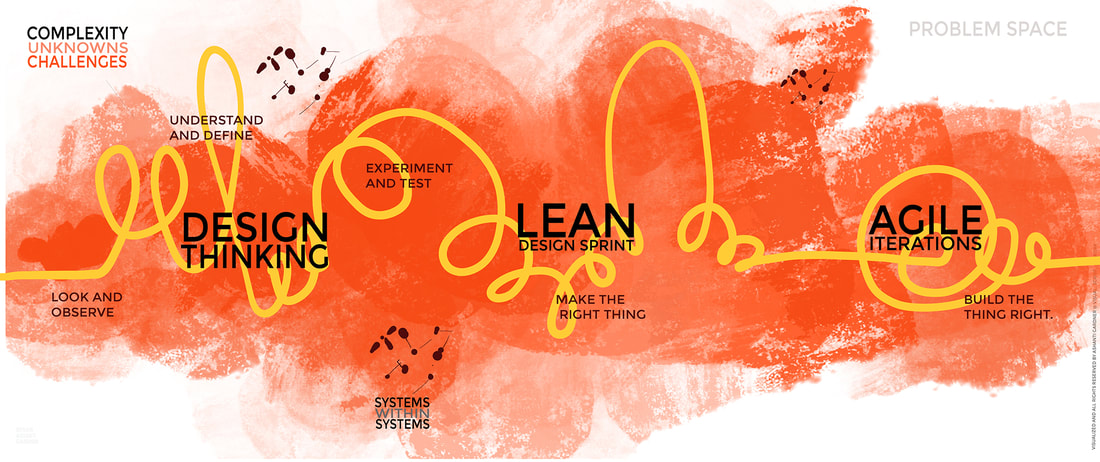|
At Illustrious, we’ve claimed to be the Leader in Team Alignment since 2022. We know what it’s like to turn the pain of transformation into the adventure of a lifetime. We’ve seen first-hand the amazing results that our clients get by working with us. And we always find it difficult to explain them to people who are curious about what we do – or curious about whether engaging us would be a good fit. So, during our recent 2024 Power Visioning Retreat – where we took a look back at what we accomplished in 2023 and imagined what we will accomplish in 2024 – we asked ourselves the question, “How are we specifically contributing to Team Alignment?” After exchanging some quick blank expressions, we got to work brainstorming the process we see our clients go through all the time – as they move from confusion to clarity, or from a milk crate full of tangled cables into a compelling and well-organized stage show. THE ILLUSTRIOUS FORMULA FOR TEAM ALIGNMENT:
EVOKING CURIOSITY
What usually happens first with the teams we work with is they are somehow exposed to the visual tools and frameworks we use at Illustrious – whether that’s graphic recording, The Grove’s Strategic Visioning or Team Performance models, or the various visual frameworks found in Gamestorming or Liberating Structures. Either way, there is a ‘Woah!” moment that leads to curiosity. This curiosity can look like excitement or skepticism. And while we’d prefer everyone be excited right away, it’s OK for the team to be skeptical in the beginning. One particularly resistant client said, “Hold on! We’re deciding our strategy based on cartoons?!” Few people have experienced the science of visual thinking proven out in a business environment. Few people have been through a process that starts out as stickies on the wall, moves into tension and groaning and pushback, and ends up as humans witnessing each other and hearing each other without judgment. But each small win helps make the process easier for even the most resistant in the room. INTEREST Next, the visuals tend to create a focused attention. People lean in, either to learn more about the tools (usually posters on the wall or canvases in apps like MURAL), or to pick them apart and tear holes in them. It matters little to us, as long as they’re leaning in and engaged. At this point, either in the spirit of herd mentality (agreement) or pushback (disagreement), we see two camps emerge – “I’m interested in learning more” or “I’m interested in proving this wrong.” Again, the group’s interest and engagement is what matters. Once most fears are addressed, defensiveness is taken down a notch, and people are assured that no one wants to do their job for them, the group usually starts to lean in the same direction. ORIENTATION This is when the fun starts to happen. I liken this stage to a pile of metal shavings being activated by a magnet. Slowly, and one by one, the shavings will start to wiggle and vibrate. Then, they turn in the same direction, sometimes piling on top of or crawling over each other in order to answer the pull of the magnet. And, suddenly, in a rush, they are like one body – or a murmuration of birds – having one shape, one energy, one purpose. That stirring of energy and positive provocation is what it looks like when a group is oriented together and facing a problem or objective arm-in-arm. INSPIRING COMMITMENT Finally, once the team is curious, interested, and facing the same direction, the primary aim of any visual tool or communication is to inspire commitment. The team moves away from dependence and resistance, gets clearer on their roles and responsibilities, has a better grasp on the resources they need or lack, and discovers new ways to plan and make decisions. This confidence fills the team’s sails and creates a renewed feeling of camaraderie and teamwork. Culture improves, communication improves, productivity increases. Because the team is saying “Yes” to each other – and to the mission. ### If you have questions about how this looks in action or would like to see this kind of alignment happen on your team, let's schedule some time to chat.
0 Comments
Illustrious is a leader in the change management and team alignment space. Since its founding in 2020, Illustrious has helped companies orient, pivot, scale, and simplify. Here are the four core values that drive their team of talented, visual consultants.
Energizing Creativity As artists, we believe there is a direct line between innovation or creativity and our ability to be in the present moment and improvise. This invisible line can be tense or slack. When it is tuned up it can be played like a guitar or piano. We are at our best when helping our clients create harmony from dissonance and we love helping them shine. Compassionate Curiosity As facilitators and coaches, we treat active listening as a valued skill in order to discover needs and opportunities. We genuinely like people and want to learn more about them. We cherish stories and love hearing them. People are at their best when they feel heard, valued, trusted, and understood. Belief in Human Potential As humans, we have a relentless belief in the greatness of other humans. We don’t see them in their current state of blame, confusion, uncertainty, fear, or insecurity. We see the white, hot light at their center. We see them on their path to future growth as they commit to being the ideal version of themselves. Humans are at their best when someone sees them deeply and believes in them. Commitment to Quality Outcomes As thought partners in your business, we are focused on professional mastery. That means we are committed to learning, transparent processes, dress and technical rehearsals, and enthusiastic attention to detail. The sooner we get it right, the sooner you can identify the bright line through your organization’s thinking. A business is at its best when its leaders and teams are aligned on the vision, culture, story, and strategy. According to Turi McKinley, Executive Director at frog design, “Design thinking is just a fancy name for the creative process.” The ability to think like a designer, through multiple iterations, and learning from the worst failures is the most important skill a leader can have. Design thinking is rooted in empathy and the ability to put the customer or client at the center of the journey. Design thinkers use physical and virtual space to expand and extend their intelligence and are unafraid to try new things. The best design thinkers use visual tools to explore new avenues of value for the business. The executive should be testing and building not just products, but entire worlds. Here are the top four abilities of design thinkers. They can be used to directly address the four problems of business (listed below) and they are so simple you can start practicing them today. 1. Frame (and Re-Frame) the Problem Take a step back, look at it from a different angle. Use multiple lenses and literacies interchangeably. What does it look like as a spreadsheet? A project plan? A to-do list? A GANTT chart? A drawing with Sharpies on butcher paper? Consider the human impact (subjective), the organizational or relational impact (intersubjective), the business or bottom line impact (objective). Ask yourself, “How else might I/we look at this?” Give yourself permission to play, be curious and creative. 2. Enable Experimentation There is no such thing as failure. View everything as an experiment, and you will always get results. If you are always testing and learning, then you will have valuable data that can be reviewed and synthesized into your next launch. Additionally, it stands to reason that results from testing on any target group will carry over to similar users. Design thinking is less of a process and more of a sequence. Model a bias toward making in the business (always be prototyping) and schedule time for this to happen. If it’s not on the calendar, it’s not real. 3. Communicate Your Ideas As a leader, you must come back from (not overcome) the exhaustion, overwhelm, and fatigue. After regaining a sense of clarity and purpose, you must be able to open your mouth and broadcast those big, wild, visionary dreams to the team again and again -- “painting done” until it’s done. Smart leaders know they must do this visually. Think of the coach at the front of the room sketching out the play on the whiteboard. Think of the best PowerPoint presentation you’ve ever seen (OK, I lied, that one doesn’t exist). Think of the first time you were shown how to use a tool or paintbrush. Think of a political speech that moves the hearts and minds of the people. People don’t follow a business, they follow leaders. In most cases, it’s not the leader they’re drawn to, it’s the challenge that the leader is able to articulate. What challenge are you asking your team to help you overcome? 4. Direct the Team The best CEOs lead from the bottom of the pyramid. They know that they will get the results and outcomes they need through other people. Not only are they focused on a succession plan, with at least two people lined up behind them -- mentoring and teaching others what they need to know in order to succeed -- they are encouraging and facilitating collaboration among team members. The team needs to be able to turn toward each other to create tools and solutions in the leader’s absence. They should be equipped with the best resources, given permission to make decisions, given access to “lab” space where they can experiment, and given permission to fail. Demonstrate the process, model the best behavior, show them what you want done, and your team will not let you down. Four Big Problems
And, here are the top problems that business leaders find themselves in. These challenges to growth or innovation can be remedied by directly applying a little visual aptitude (and the abilities described above). 1. Big Picture Paralysis One of our clients told us their strategy felt like “a tumbled bail of rope.” They needed the line to be clear and hanging at the ready. Our job was to lead them through the process of liberating each of their lines of business from snags and knots. Business is complex and messy. And the overload of information can make our brains slow down, or worse, come to a halt. If you’re experiencing this, you may be hearing or saying things like, “I can’t get my priorities in line” or “I don’t even know where to start.” Solution: Reframe the Problem 2. Reliance on Process Sometimes we’re lazy. Sometimes we want to read a book or watch a video and have someone else give us the answers. Sometimes we want to take the easy way out. Unfortunately, in business, there is no proven method or set of instructions to follow. You are not recreating a recipe to prepare that perfect dish you saw on YouTube. You are not creating a piece of clothing from a pattern. Following steps 1-4 will not get you a repeatable outcome. When you are stuck in “step reliance,” you are destined for disappointment and you may be saying things like, “I wish someone would just tell me what to do.” Solution: Enable Experimentation 3. Exhaustion There are many reasons you feel tired. It can be from informational or emotional overwhelm. It could be the strain of mode-switching from the constant pivoting and responding that’s required in your business. It could be that you aren’t managing your time or work effort wisely. Sometimes leaders simply feel oppressed by the unknown -- a sense of uncertainty that is not the invigorating or adventurous kind. For whatever reason, if you are feeling exhausted, pushing through it will never solve the problem. Stop. Walk away. Take a breath. Take a nap or a vacation. Return with clarity and strength. Solution: Communicate 4. Overcontrol Holding on too tightly to the reins of your business will limit collaboration and severely hamper the open sharing of ideas. You might be creating the illusion of collaboration by having meetings where the team brainstorms possibilities only to end up returning to your original thought or argument, saying, “well, we really have to do this” or “I’ve made an executive decision that we will go this way.” If you are focused on control, you may also be too concerned with things like loyalty or team members being “all in” instead of measuring and getting actual results. Solution: Direct the Team |
Details
ABOUT THE AuthorJoran Slane Oppelt is an international speaker, author and consultant with certifications in coaching, storytelling, design thinking and virtual facilitation. Archives
March 2024
Categories
All
|




 RSS Feed
RSS Feed